
An historical overview of the origins of the U.S. Electoral College
- Subject:
- History, Law, Politics
- U.S. History
- Material Type:
- Lesson
- Lesson Plan
- Author:
- Eric Denyer
- Date Added:
- 05/08/2024

Materials that have been endorsed and vetted by U.S. Capitol Historical Society education team as part of the We the People Digital Learning Hub.
The U.S. Capitol Historical Society is a nonpartisan educational 501(c)3 nonprofit organization, chartered by Congress in 1978, in part “to foster and increase an informed patriotism."
The USCHS education team follows ISKME's Open Educational Practice Rubric.

An historical overview of the origins of the U.S. Electoral College
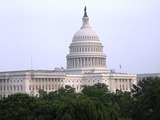
At OSPI, part of our mission is to prepare students for civic engagement throughout their lives. We believe our schools must engage and empower students, from an early age, with opportunities to participate in civil conversations, examples of effective civic engagement, and tools to find peaceful solutions to community problems.OSPI’s Social Studies and Social-Emotional Learning teams have put together resources for educators, families, and students to help with these difficult conversations.
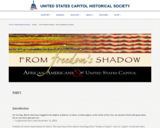
Freedom for some meant slavery for others. The cruel irony of this nation’s founding and its “Temple of Liberty”—the U.S. Capitol—is that both were made possible by the enslavement of African Americans.
The labor of enslaved and free blacks helped build the Capitol. An enslaved African American man helped to cast the Statue of Freedom, which was placed atop the Dome during the Civil War.
Since the end of the Civil War, African Americans have struggled to move out of the shadows and into the Temple of Liberty as full participants.
This the online version of a traveling exhibit by the U.S. Capitol Historical Society that depicts the journey of African Americans from slavery to freedom and political representation in the U.S. Capitol. The exhibit opened February 2006 in Baltimore, Maryland at the Reginald F. Lewis Museum of Maryland African American History and Culture.

In this activity, students will analyze documents from the War Department’s Bureau of Refugees, Freedmen, and Abandoned Lands — better known as the Freedmen’s Bureau — that Congress established on March 3, 1865, as the Civil War was coming to an end. Using the scale in Weighing the Evidence, students will evaluate the effectiveness of the Freedmen's Bureau in assisting formerly enslaved persons.
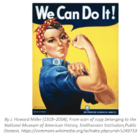
The first wave of the Women’s Liberation Movement (also known as “feminism”) occurred during the mid to late-1800s. The main objective was votes for women. In the mid-1960’s, the second wave of feminism appeared with a goal for women to obtain a stronger role in American society. This lesson will examine the second wave of the Women’s Liberation Movement by exploring the changes in the traditional role of women and discovering the role that The Feminine Mystique played in those societal changes. You will discover how the Women’s Movement is still pushing for equality today.StandardsCC.8.5.9-10.D Determine the meaning of words and phrases as they are used in a text, including vocabulary describing political, social, or economic aspects of history/social science.CC.8.6.9-10.G Gather relevant information from multiple authoritative print and digital sources, using advanced searches effectively; assess the usefulness of each source in answering the research question; integrate information into the text selectively to maintain the flow of ideas, avoiding plagiarism and following a standard format for citation.
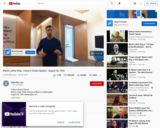
I Have a Dream Speech. Martin Luther King's Address at March on Washington, August 28, 1963. Washington, D.C.

In this activity, students will examine documents from the FBI case file about Bloody Sunday in Selma, Alabama. They will answer questions to show understanding of the events that took place, and how the spread of information about Selma impacted the Civil Rights Movement. They will also be asked to think about whether the Federal Government would have acted differently if the FBI knew that the public may be able to see their files — the Government was not required to release records like this until the Freedom of Information Act (FOIA) gave the public the right to request Federal agency records in 1966.
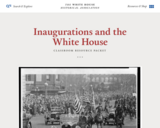
An inauguration is the act or ceremony of bringing someone into a position or an office. Every president of the United States has been inaugurated, dating back to the first executive, George Washington. These inaugurations symbolize a peaceful transition of power between administrations. Although the Constitution provides an oath for the new president to take, all other elements of the modern presidential inauguration grew from traditions, changes, and preferences that evolved over 200 years. As the president's residence, the White House plays an important role in inaugurations. Gain a deeper appreciation of presidential inaugurations and transitions at the White House by learning about the history behind the Oath of Office, inaugural parade, parties, and more.
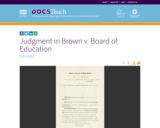
On May 17, 1954, in Brown v. Board of Education of Topeka (five separate cases consolidated under a single name), the U.S. Supreme Court ruled unanimously that separate but equal public schools violated the 14th Amendment.
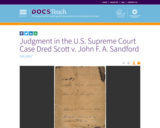
In this ruling, the U.S. Supreme Court stated that slaves were not citizens of the United States and, therefore, could not expect any protection from the Federal Government or the courts. The opinion also stated that Congress had no authority to ban slavery from a Federal territory.

This photograph of a sculpture of Mary McLeod Bethune by Selma Hortense Burke is part of Harmon Foundation Collection. The Harmon Foundation, a nonprofit, private foundation active from 1922 to 1967, helped foster an awareness of African art. African artists would send their artworks to the United States for exhibit and sale. When the foundation ended its activities in 1967, it donated its entire collection of motion pictures, filmstrips, color slides, and black and white prints and negatives on a variety of subjects to the National Archives. Selma Hortense Burke (b. December 31, 1900, Mooresville, North Carolina - d. August 29, 1995, New Hope, Pennsylvania) was an American sculptor, educator, and member of the Harlem Renaissance movement. Burke created many pieces of public art, often portraits of prominent African-American figures like Duke Ellington, Mary McLeod Bethune and Booker T. Washington. She received national recognition for her relief portrait of Franklin Delano Roosevelt, which was the model for his image on the dime. In 1979, Burke was awarded the Women's Caucus for Art Lifetime Achievement Award.Learn more on our main National Archives website.
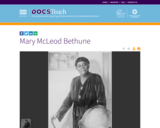
This photograph is from series is a collection of black-and-white and color photographs of a set of oil paintings "Portraits of Outstanding Americans of Negro Origin" commissioned by the Harmon Foundation. The set originally comprised 22 portraits painted by Betsy Graves Reyneau and Laura Wheeler Waring. Overtime the number of paintings increased to 47.The Harmon Foundation, a nonprofit, private foundation active from 1922 to 1967, helped foster an awareness of African art. African artists would send their artworks to the United States for exhibit and sale. When the foundation ended its activities in 1967, it donated its entire collection of motion pictures, filmstrips, color slides, and black and white prints and negatives on a variety of subjects to the National Archives. Betsy Graves Reyneau (1888-1964) studied at the Boston Museum of Fine Arts shortly before World War I. She continued her studies in Cincinnati, Ohio; Paris, France and Rome, Italy. Following her studies, Reyneau maintained a studio in Detroit, MI for a number of years. Then in 1927, she moved permanently to Europe, only to leave 12 years later due to the rise of fascism.Returning to the United States, Reyneau was shocked by the overt racism that existed in the 1930s. She decided that by using her skills as a portrait painter she could do something that would make a difference in the country's perception of African Americans. Reyneau's determination eventually resulted in a set of portraits commissioned by the Harmon Foundation. The individuals chosen were prominent African Americans who had distinguished themselves by their service to humankind.Learn more on the National Archives website.
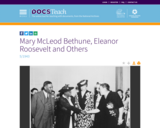
The original caption for this photograph reads: "Mrs. Eleanor Roosevelt and others at the opening of Midway Hall, one of two residence halls built by the Public Buildings Administration of FWA for Negro government girls."As a presidential advisor of African American Affairs during the Roosevelt administration, Mary McLeod Bethune formed the Federal Council of Negro Affairs, which would become known as the Black Cabinet. The Black Cabinet was instrumental in creating jobs for African Americans in Federal executive departments and New Deal agencies.Bethune’s influence within the Roosevelt administration also allowed her to direct funds created by the New Deal program to Black people. Programs such as the Works Progress Administration (WPA) and National Youth Administration (NYA) were successful in employing over 300,000 African Americans during the Great Depression.The original caption for this photograph uses the term "negro" to refer to Black people, which was commonly accepted in that era, but is outdated and inappropriate today.
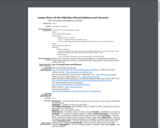
In this lesson, students will explore the biography of Mary McLeod Bethune and primary resources related to her life in order to understand the impact she had on other people, and how her example of integrity and principle can affect their own lives today.

This activity “Becoming aware of the Japanese American Internment Camp Experience” is intended to help students become aware of, and sensitive to, the Japanese American interment camp experience. They will develop a sense of empathy by simulating the situations which Japanese American children faced.

President John Adams sent this message nominating John Marshall to be Chief Justice of the Supreme Court.
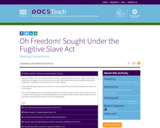
The road to Emancipation was indeed stony! Enslaved people struggled to free themselves and loved ones, one person at a time.
This activity includes primary sources from the official records of the U.S. District Court at Boston that tell the story of William and Ellen Craft, a young couple from Macon, GA, who escaped to freedom in Boston in 1848. The two traveled together, Ellen as a White gentleman (she was the daughter of an African-American woman and a White master and passed as White), and William as her slave valet. They made their way to Boston, and lived in the home of Lewis Hayden, a former fugitive and abolition activist.
With the passing of the Fugitive Slave Act in September, 1850, the Crafts' respective owners employed the legal system to regain their escaped property. A U.S. Marshal was sent to the home of Lewis Hayden. Hayden refused to let the marshal in and threatened to ignite kegs of gunpowder; the Marshal left. Ellen and William fled to Britain, where they remained for 20 years. They eventually returned to the United States and settled back in Georgia.
In this activity, students will examine historic documents about these fugitives from slavery. Then, using the documents, they will construct historical narratives to tell their story. They can explore perspective and use standard elements of writing (plot, character, setting, conflict, impact). Thinking about essential questions/topics, they will begin their writing with a topic/opening sentence that sets out the main idea.
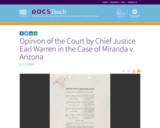
In 1963, Ernesto Miranda was arrested in Arizona and charged with kidnapping, robbery, and rape. When questioned by police, Miranda confessed. He was tried and convicted based on his confession. Miranda appealed his conviction to the U.S. Supreme Court, which ruled in 1966 that statements made by the accused may not be admitted in court without procedural safeguards. Page 31 from the decision describes two of those safeguards—the accused’s right to remain silent and to have an attorney present during questioning. Selected pages are shown.
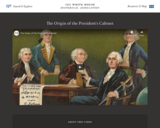
Learn about George Washington's creation of the cabinet, an advisory group for the President of the United States of America, and the cabinet's place in White House history. Featuring Dr. Lindsay Chervinsky, historian at the White House Historical Association and author of The Cabinet: George Washington and the Creation of an American Institution (available April 2020).
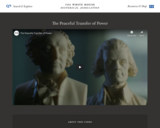
The White House is a stage for the peaceful transfer of power from one administration to the next. Discover how the transfer from John Adams to Thomas Jefferson set this precedent. Featuring Dr. Matthew Costello, Senior Historian at the White House Historical Association.